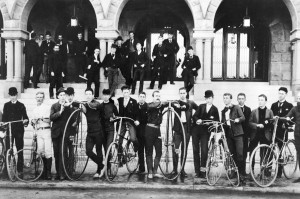A flurry of emails circulated among the student body earlier this quarter, sent by students warning their peers of a recent upsurge in biking citations by police officers stationed strategically around campus at various intersections. This increase was only one part of a larger and ever-growing movement on campus to promote bike safety.
Of the proponents of this movement, the Stanford Department of Public Safety (SUDPS) is a major force.
“If you’ve ever been the first person to an accident scene where there are serious injuries, it’s pretty traumatic,” said Deputy Allen James. “I liken it to being in wartime because I spent two years in Vietnam.”

James came to Stanford 20 years ago after working on the force in the East Bay. In addition to his other duties, he teaches the SUDPS bicycle safety diversion class, a one-hour class usually taught twice a month that allows students to void their bicycle citations in favor of bicycle safety education. The $194 fine that accompanies a bike ticket is part of what pushed James to become involved in the movement and the class.
“I always felt so bad when we were out here trying to enforce the law, because I would look at the students, and I’m thinking, ‘They’re going to be eating Top Ramen noodles for months to pay this stupid ticket,’ because I knew how much it was,” James said.
The bike safety movement emphasizes a collaborative effort among various departments on campus. James, for example, works closely with Ariadne Scott, bicycle coordinator at Parking and Transportation Services (P&TS). An avid cyclist, Scott aims to promote bicycle usage while implementing programs to enforce student safety. She has not owned a car in over 23 years.
“I think bikes symbolize freedom and the power to move and be self-propelled, …especially with global warming and the idea that you can actually do something to offset that carbon [emission] by not driving. You can have a direct [impact on] making the world a better place,” Scott said. “We want people to ride–we just want people to be safe.”
Some of the new measures designed to promote safety include stronger enforcement of bike laws, a bike safety summit in November with the Stanford Trauma Center and signs below stop signs that read, “Bikes are required to stop at all stop signs.” P&TS sponsored a Bike Safety Dorm Challenge this past fall in which the winning dorm, Muwekma-tah-ruk, won a free charter bus to Tahoe.
As a result, Stanford has been designated the first and only Bicycle Friendly University at the Platinum level, the highest distinction given by the League of American Bicyclists.
Ultimately, campus administrators agree that students must be the driving force ensuring the movement’s success in changing campus culture–especially in reducing the negative perception of helmet use.
“All student leaders have a huge role in this, as is true for a lot of other topics,” wrote Donnovan Yisrael ’89, manager of Relationship and Sexual Health Programs and member of the “I Thrive @ Stanford” unit at Vaden Health Center, in an email to The Daily. “If an RA [residential assistant] or PHE [peer health educator] in an all-frosh dorm stands up and says, ‘We want you all to wear helmets and we are going to model that by all of us wearing helmets,’ that is a powerful message.”
Students with personal bike accident experience are some of the most vocal advocates for bicycle safety and awareness. Kali Lindsay ’12 is one such advocate. During her sophomore year, on her way to an appointment with an oral communication tutor, Lindsay was involved in a serious bike accident.
“I kind of remember getting off my bed, and that was the last thing I remembered,” Lindsay said. “The next thing I remembered, really clearly, was my parents getting to the hospital about 2 a.m. …more than 12 hours later.”

Though Lindsay was unable to recall the event itself, witnesses later told her that she had fallen between freshman dorm Larkin and Meyer Library, hitting her head on the right temple. She sustained epidural hematoma, an injury involving bleeding between the skull and brain. The injury caused initial short-term memory loss and dizziness, which prevented her from reading for almost two months, forcing her to take the rest of fall quarter off.
“When you’re young you think, ‘Well, this can happen to me, and if it does happen, I’ll be fine,’” Lindsay said. “I started realizing this is real, and this is more than just a one-time thing…it felt like I couldn’t control my mind anymore.”
While she was able to return for winter quarter of that year, it would be a year and a half before Lindsay felt like her former self again. She experienced unexpected panic attacks in seemingly innocuous situations and had to undergo therapy to overcome her emotional instability. She is now a freshman RA and has become involved in campaigning for helmet usage and bike safety.
“It’s hard when I still see my freshmen going around and not wearing their helmets,” Lindsay said. “It’s hard to get up every day to go to class and see people biking without their helmets, texting [or] riding on each other’s handlebars.”
She worked with both Scott and James, along with the Office of Residential Education (ResEd), to fund bike helmets for her entire dorm, Larkin. The program has been expanded to fund the purchase of helmets for all freshman dorms and “everyone who wants them,” according to James.
While helmet usage is far from becoming the norm, the accounts provided by students such as Lindsay and the efforts of P&TS and the SUDPS may be beginning to take effect.
“I’ve been on campus on and off since 1985, and I’ve never seen this much attention being paid to promoting helmet wearing,” Yisrael said. “I’m hoping that we are reaching a ‘critical mass.’”
